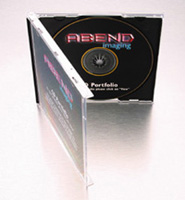Putting Your Portfolio On CD ROM
The Technology Is There, But Is This Any Way To Show Your Work
|
Last year I wrote about the need for every photographer, regardless of their ability, to have a current portfolio. In my business as a commercial photographer, a killer portfolio is a necessity. I received a few e-mails inquiring about the new trend toward portfolios on CD-ROM, so I investigated. There are any number of ways to put a decent CD-ROM of your work together, but my first question is, why? Besides my portfolio, bimonthly promotional post cards and web site, do I really need another way to market my images? Well, according to the kind of work you're looking for, the answer may be yes. Obviously the task of either personally showing a portfolio or FedExing one around the world can become tiresome and expensive. While a web site is an excellent way to give clients a glimpse (albeit a low-res one) of a nice cross-section of my work, I'm severely limited by bandwidth. I'd love to include sharper, larger files, but the site would be deathly slow. According to photographers I've spoken with and my own experience, a portfolio on CD-ROM allows for higher res images, more special effects and other normally bandwidth-choking features. The Routes To A CD Protection Concerns When distributing a CD-ROM portfolio you have the question of how much is enough? If I include very small images then they're very difficult to use for any commercial application, so they're practically theft-proof. If I include higher resolution images then they look great on screen, but now they might be good enough to be pirated. After all, once you send out a CD to someone you really have no control over how or where it is used. This issue of copyright protection and the preservation of your work is a sticky one. I hate to be so paranoid, but every working commercial photographer at some point will find their work showing up somewhere without their permission (or any additional compensation). |
|||
The Creation Process A lot of photographers are going with image catalog software that takes a folder of images and creates a ready-to-view "Portfolio." Craig Edwards, a photographer in Big Sandy, Montana, has a CD portfolio created with Flip Album software (www.flipalbumcd.com). Edwards scans proofs from his portrait sessions and uses these to create a photo flip album. The nice thing about his package is that you can either click on the thumbnails on his "Index" page, or just let the scrapbook format flip through the pages and see the whole show in order. The problem with most of these packaged portfolio software arrangements is that they are PC only, and my clients live in a Mac-Centric world. Web To CD I've seen some amazing HTML portfolios with excellent Flash graphics, mini Quicktime movies, awesome soundtracks, and incredible design sense. My own personal sense of the market is that people are getting fed up with too much flash, so I've stripped my once elaborate site down to a simple black background, lots of pictures layout. |
|||
Create A Site Very slick HTML generators are contained in ACDSEE (www.acdsystems.com), Thumbs + (www.cerious.com), and Compupic Pro (www.photodex.com). These image browsing programs allow you to create quickie web sites with a bit more design sense, and they do the job a bit faster than Photoshop. (They're cheaper, too.) The ACDSEE web site is a terrific place to shop as well, with PhotoAngelo looking like a nice tool to create image slide shows that run on any PC. Distribution Matters Have you ever sat down and tried to copy 300 CD-ROMs? It's a daunting task. Even if you just use you spare time it's a brutal endeavor. Add to that all of the labeling, CD sleeve printing, scoring, and folding. Wow! What a job. What's your time worth? Getting CDs professionally burned and printed is a surprisingly affordable process. CD duplicators like Disc Makers (www.discmakers.com) not only duplicate your discs, but they offer a lot of different options for printing and packaging. To have 300 CDs burned and screen printed with up to three colors is only $885. Add a professionally printed four color cardboard sleeve and you're only up to $990. For a couple of cents more you can add a jewel case or any number of other presentations like fold out cardboard mailers. I like the idea of the fold out sleeve, since you can add some more information about your work, your business, and maybe even some personal info. There are dozens of other CD duplication houses out there--a simple web search will turn up plenty of hits. It's never been easier to create a digital portfolio and distribute it. While it still costs hundreds of dollars to print up a full portfolio, a reasonable approximation can be burned to CD for a couple of dollars and mailed like a letter to anywhere. If you're comfortable with your work going out in the mail with no promise of its return, then a CD portfolio might be the right tool for your own self-promotion. Different types of photographers are choosing different CD formats, from simple HTML designs to complex autorun movies. I've had a pretty good reaction to my own CD portfolio, and have just ordered another 500 copies for a little over $1000. Time will tell if this new batch will pay off. |
- Log in or register to post comments




















































